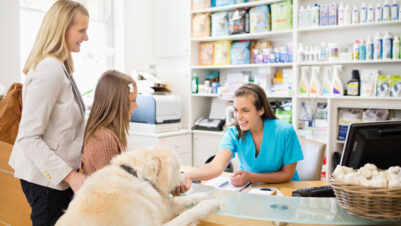
As veterinary leaders and managers, it’s vital that we recognise the desire veterinary receptionists have to learn new skills and master old ones. The British Veterinary Receptionist Association (BVRA) annual survey 2021 found that just 36 percent of veterinary receptionists were satisfied with the learning and development opportunities that they received. Practice meetings are a vital lifeline to supporting the growth in this statistic, as getting your reception team together for a group session can really support their development.
Promote development
When considering how practice meetings are delivered, it’s important to keep everything relatable to the vital role that receptionists take within your practice. It’s great to see that last year 66 percent of veterinary receptionists received CPD allowances, whether this was monetary or time allocated, to develop themselves within their roles. It will be interesting to see if that figure is higher this year in the 2022 survey results, especially now that we are learning to live with COVID and easing the restrictions in practice. We should now be able to meet more regularly in larger teams and invite external speakers into our surgeries.
CPD is vital, not only for the benefit of the clients and the practice, but to help make receptionists feel as valued as some of the other departments do
Vets and nurses are given a CPD allowance every year by their practices to stay on top of training and we are seeing this become more available for receptionists too. CPD is vital, not only for the benefit of the clients and the practice, but to help make receptionists feel as valued as some of the other departments do. CPD can easily be given in the form of a practice meeting, whether this is an external company coming into the practice or led by one of our colleagues. It can be a cost-effective way for practices show their staff that they are valued, by offering staff the resources and support to succeed in their role. As a registered veterinary receptionist you are required to complete at least five hours of CPD every year, and practice meetings could support this easily.
Moreover, according to the BVRA 2021 survey, 64 percent of veterinary receptionists want to do more CPD. There should be a push to get receptionists learning, and in some practice meetings why not get vets and nurses to deliver sessions? It can be a valuable resource within your practice and all that is required is for time to be allocated for your clinical team to run the meetings. Your clinical team can teach your reception team vital information that can help make situations easier for everyone involved in the day-to-day running of the practice. This can also help with breaking down any cross-team barriers, supporting bonding between teams and colleagues.
Practical considerations
Having regular meetings in veterinary practice has many benefits for not only the team, but our clients and their pets. It allows us to keep up to date with training, discuss and improve practice protocols, build relationships with our colleagues, update staff on how the business is doing and even help boost morale. It is very easy for distractions to occur and concentration to fade when the speaker drifts away from the topic of the meeting, therefore there are a number of additional practical steps to consider to ensure practice meetings keep on track.
Be proactive
It is important to have a designated “note-taker” during meetings, not only for team members who can’t be present, but to remind the team of what was discussed and to have a paper trail to refer back to in future meetings if necessary. When planning dates, try to avoid days when there are lots of staff holidays to ensure as many team members can be present as possible. Send reminders to the team with location details or the link to join if it’s a remote meeting. It can also be beneficial to allocate a chairperson to control the timing and the agenda, and to make sure that only one person is speaking at a time.
Focus on variety
As hard as it can be to find time in a busy vet practice to round up many employees from different departments, it can be vital for team building and boosting morale
Practice meetings should vary between teams and topics, and they should be light-hearted, informative and kept relevant to the subject. Mixing the meeting participants is also beneficial and needs to be considered when you are planning on how to get the most out of each session. You’ll often find that by having a representative from every department, ideas will be more diverse and it can help to promote a democratic workplace. However, this isn’t always appropriate: for example, if the goal of the meeting is to update employees on how the business is doing, an “all practice meeting” may be more suitable so everyone is informed at the same time, in the same way. If a meet-up is required to discuss and implement a new protocol for a particular department, it would be more suitable to hold the meeting with only those affected.
As hard as it can be to find time in a busy vet practice to round up many employees from different departments, it can be vital for team building and boosting morale. The frequency of meetings will vary from practice to practice but should be consistent enough to promote a stronger and more positive working environment.
Summary
Overall, it is important to take a proactive approach to handling practice meetings. Don’t leave organising them until the last minute as you need to be confident in delivering your message in any meeting, and by being organised you will feel enabled to give a clear delivery. It’s also important to give everyone a chance to speak and ask questions in meetings, and to open the door for questions afterwards in case those taking part aren’t comfortable doing so in a group scenario.












